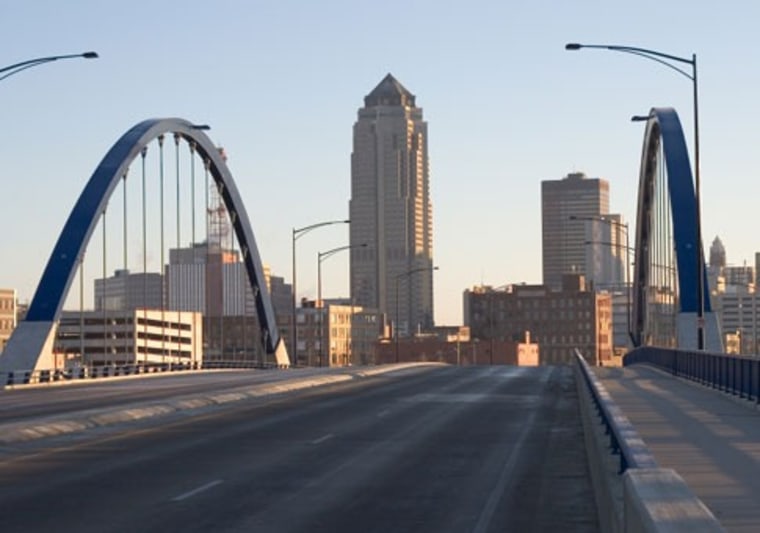The Great Recession ravaged almost every big city across the United States in 2009. Home prices were down in 182 of the 200 largest metro areas, while household incomes fell in 94 percent of these areas. The employment picture was even tougher: only four areas posted positive job growth with a paltry gain of just 4,300 positions created — combined. The other 196 metros together lost 3.5 million jobs last year.
The worst may be over, but businesses on both coasts still face outrageous costs and indebted state governments with budget shortfalls that will have to be filled from the flesh of local firms. Those problems won't be resolved anytime soon.
What to do? Our 12th annual ranking of the Best Places for Business and Careers has an answer: Move to Middle America.
The top of this year's list is filled with cities in so-called flyover states, areas with reasonable business costs, strong economic outlooks and a solid quality of life.
Leading the way is Des Moines, Iowa, which grabbed our top spot after ranking seventh last year. Iowa's capital has 562,000 people in the metro area and features business costs 15 percent below the national average (living costs are 10 percent below the national average). It has an educated labor supply as 33 percent of adults have college degrees (ranking 46th among the 200 largest metros) and 92 percent possess high school diplomas (ranks 19th).
"Des Moines' favorable regulatory environment and well-educated workforce makes it an attractive destination for high-value-added, well-paying industries," says Sunayana Mehra, an economist at Moody's Economy.com. The financial industry has set up shop in Des Moines, with Wells Fargo and Principal Financial being the largest employers in the area with 19,000 employees between them. Other big employers include insurers Nationwide Insurance and Marsh & McLennan.
The economic outlook is bright in Des Moines as well. Employment is expected to increase at a 2.7 percent annual clip over the next three years, 10th best in the country. Meanwhile, household incomes are projected to rise 2.9 percent, which ranks 11th.
Des Moines city manager Richard Clark points to the area's quality of life as a big draw for corporations. Housing is affordable with a median home price of just $149,000, one-quarter the price of a home in the San Francisco area. Commute times, according to the Census Bureau, average 19.8 minutes, one of the fastest in the U.S.
Getting outside is easy, too. Des Moines designed a system of more than 300 miles of trails in and around the city for running, walking, biking or in-line skating. A 4.4-acre public park and sculpture garden opened downtown in September. Local venture capitalist John Pappajohn and his wife Mary donated $40 million of sculptures to the project from their personal collection. The park is surrounded by the offices of Wellmark Blue Cross Blue Shield, Nationwide and ING.
Our ranking of Best Places looks at the 200 largest metropolitan statistical areas in the U.S., which range in size from the New York City metro, with 11.7 million people, to Merced, Calif., home to 245,000. We ranked areas on 12 metrics including costs (business and living), job growth (past and projected), income growth, educational attainment and projected economic growth.
We also factored in quality-of-life issues like crime, cultural and recreational opportunities as well as net migration patters. Lastly we examined the percentage of subprime mortgages handed out over a three-year stretch and the number of highly ranked four-year colleges in the area, per our annual college rankings.
Most of the figures used were provided by research firm Moody's Economy.com. Data for crime (FBI) and educational attainment (Census) came straight from the government. Demographer Bert Sperling created a culture and leisure index for Forbes.
Last year's winner, Raleigh, N.C., dropped to third this year. The long-term outlook in Raleigh is still strong, but 2009 was rough. Incomes fell 5.9 percent and unemployment averaged 8.6 percent for the year, compared with 4.9 percent in 2008. “The recession has hit the area hard, with the restructuring in the pharmaceutical industry and with dry credit markets greatly reducing access to financing for startup firms," says Economy.com economist Jimmy Jean. Six North Carolina metros ranked in the top 20 last year, but this year only Raleigh and Charlotte made the cut.
Looking at California metros shows both the good and the bad the state has to offer. California cities Modesto, Vallejo and Merced occupy the bottom three spots in our rankings. All three areas have seen net migrations out of the cities over the past five years and were hit hard by the housing crisis. Each metro has a significant number of subprime mortgages on the books.
The top Golden State locales were San Francisco (ranked 38th) and San Jose (ranked 48th). Economy.com figures that San Fran and San Jose are the two most expensive cities in the country in terms of living costs. Business costs for both are also in the top five. Yet the Bay Area and Silicon Valley are able to overcome these onerous costs thanks to a strong university presence and an abundance of cultural and recreational opportunities that attract a highly educated labor supply. The economies of both areas are expected to be among the 10 most vibrant over the next three years with annual gross metro product growth of 5.8 percent in San Jose and 5.7 percent in San Francisco.
